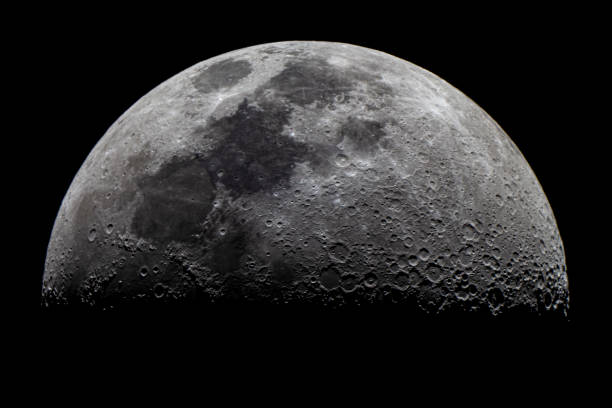Gazing upward on a clear night, the Moon’s luminous presence dominates the celestial canvas. We hold a special place in our hearts and history for Earth’s lone companion, but it’s just one member of a diverse family of moons scattered across our solar system. These captivating orbs, orbiting planets both familiar and distant, offer a glimpse into the fascinating variety of celestial bodies lurking within our cosmic neighborhood. Today, we embark on a journey to unveil the top 10 largest moons in our solar system , exploring their unique attributes and the tantalizing possibilities they hold.
Ganymede: King of the Moons

Ganymede is the largest moon in our solar system, with a radius of 1,635 miles (2,631 kilometers), bigger than Mercury and Pluto. Galileo Galilei named it on January 7, 1610. It is the only moon known to have its own magnetic field, causing auroras, and it harbors an underground saltwater ocean estimated to be 60 miles (100 kilometers) thick, ten times deeper than Earth’s. Ganymede’s surface is a mix of two types of terrain, with 40% covered by highly cratered dark regions and the remaining 60% covered by a light grooved terrain. Several NASA probes have explored Ganymede, including the Juno spacecraft, which took detailed photographs of the moon in June 2021. Ganymede’s tidal locking to Jupiter causes it to keep the same face turned toward the planet during its orbit, which takes 7.1 days to complete at a speed of 39,165 km/h.
Juno currently orbits Jupiter, unraveling its secrets, and hopefully shedding light on the formation and evolution of Ganymede and its fellow satellites. These insights will be crucial in understanding not only our own solar system but also the vast possibilities hidden within the cosmos.
Titan: A World with Liquid Methane Seas

Titan, Saturn’s largest moon, is a world of remarkable features. It possesses a dense atmosphere primarily composed of nitrogen and methane, making it the only moon in the solar system with a substantial atmosphere. What sets Titan apart is its surface, which showcases rivers, lakes, and seas of liquid hydrocarbons such as methane and ethane, a phenomenon not found elsewhere in the solar system. This unique characteristic has piqued scientific interest in the moon’s potential for habitability. In addition to its unusual atmosphere and surface, Titan’s size is also noteworthy.
It is larger than the planet Mercury and is the second largest moon in our solar system, surpassed only by Jupiter’s moon Ganymede. A golden hazy atmosphere shrouds the surface of the moon, concealing Earth-like landscapes of lakes, rivers, and sand dunes, albeit composed of entirely different materials.
Several space missions have contributed to our understanding of Titan. The Cassini orbiter and Huygens probe provided detailed studies of its atmosphere and surface, unraveling the moon’s unique characteristics. Looking to the future, NASA’s Dragonfly mission, set to launch in 2028, aims to explore Titan’s surface and investigate its prebiotic chemistry, potentially shedding light on the moon’s habitability. While there is currently no evidence of life on Titan, its complex chemistry and unique environments make it a compelling subject for studying conditions suitable for life. The moon’s potential for habitability and its intriguing characteristics have also made it a popular subject in various forms of media, including films, television shows, and literature.
ALSO READ: The Rise of Suborbital Tourism and its Impact on Travel
Did You Know?
As exotic as Titan might sound, in some ways it’s one of the most hospitable worlds in the solar system. Titan’s nitrogen atmosphere is so dense that a human wouldn’t need a pressure suit to walk around on the surface. He or she would, however, need an oxygen mask and protection against the cold—temperatures at Titan’s surface are around minus 290 degrees Fahrenheit (minus 179 Celsius).
NASA
Callisto: A Heavily Cratered Time Capsule
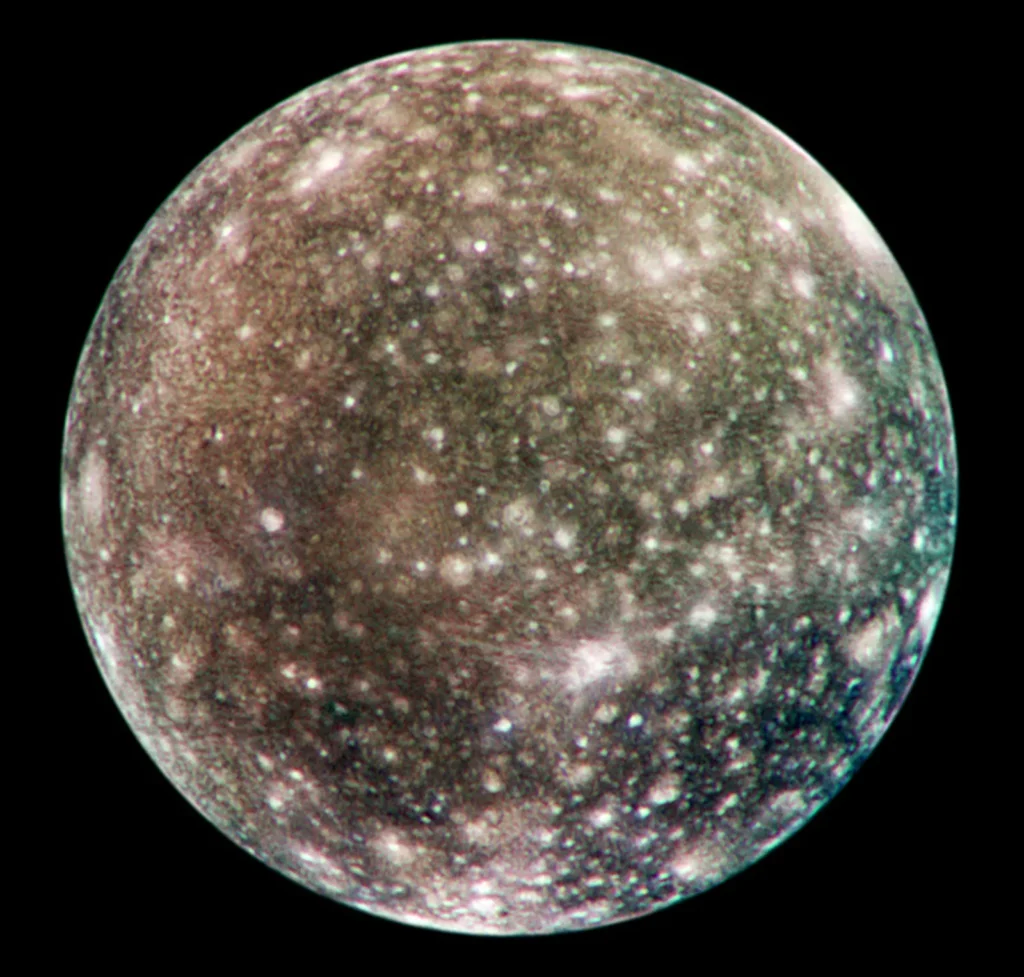
JPL/NASA/DLR
Callisto, one of Jupiter’s largest moons and the third-largest moon in our solar system, is a world of ancient and intriguing characteristics. Its heavily cratered surface indicates a lack of significant geologic activity. The moon’s icy surface, estimated to be around 4 billion years old, bears the scars of numerous impacts, creating a unique and rugged landscape. Unlike some of Jupiter’s other moons, scientists think Callisto has little geologic activity, lacking active volcanoes or tectonic processes that would erase the evidence of impact craters.
However, scientific data, including observations from the Galileo spacecraft, have suggested the presence of a subsurface ocean beneath Callisto’s icy crust. This subsurface ocean, if confirmed, could make Callisto a potential candidate for hosting extraterrestrial life. Callisto’s formation and evolution have contributed to its distinct characteristics. Its gradual accretion and the absence of significant tidal heating meant that there was not enough heat for rapid differentiation. As a result, the interior of Callisto may have undergone partial differentiation, possibly leading to the formation of a subsurface ocean at a depth of 100–150 km and a small, rocky core.
Several space missions, including Pioneers 10 and 11, Galileo, and Cassini, have provided valuable insights into Callisto’s composition, surface features, and potential for harboring a subsurface ocean. Due to its relatively low radiation levels compared to other Jovian moons, scientists have considered Callisto a potential candidate for future crewed missions to study the Jovian system. Galileo Galilei and Simon Marius independently discovered Callisto in 1610, naming it after a nymph from Greek mythology associated with the goddess of the hunt, Artemis. Its rich history and unique characteristics make it a subject of continued scientific interest and exploration.
Io: A Fiery Dance of Volcanic Majesty
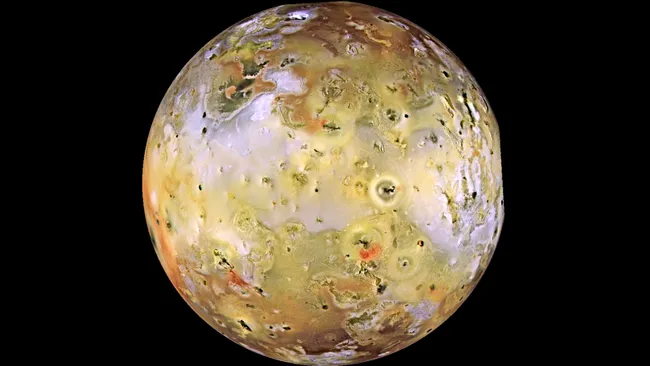
Io, the innermost and third-largest of Jupiter’s four Galilean moons, is a world of extreme volcanic activity and unique characteristics. It is the most volcanically active world in the solar system, with hundreds of volcanoes, some erupting lava fountains dozens of miles high. The extreme geologic activity stems from tidal heating generated within Io’s interior as Jupiter and the neighboring moons Europa and Ganymede pull on it, causing friction. Slightly larger than Earth’s Moon, Io primarily consists of silicate rock and iron, with a thin atmosphere composed mainly of sulfur dioxide.
Galileo Galilei discovered Io in 1610, naming it after the mythological character Io, a priestess of Hera who became one of Zeus’s lovers. Several space probes, including NASA’s Pioneer 10, Pioneer 11, Voyager 1, Voyager 2, and Galileo spacecraft, have provided valuable insights into Io’s composition, surface features, and volcanic activity. The Juno mission, currently orbiting Jupiter, is expected to shed light on the processes that drive Io’s extreme volcanic activity. In summary, Io’s intense volcanic activity, unique composition, and the influence of Jupiter’s gravitational forces make it a fascinating and dynamic world, offering valuable insights into the processes of volcanism and tidal heating in the solar system.
Our Familiar Moon: Earth’s Faithful Companion
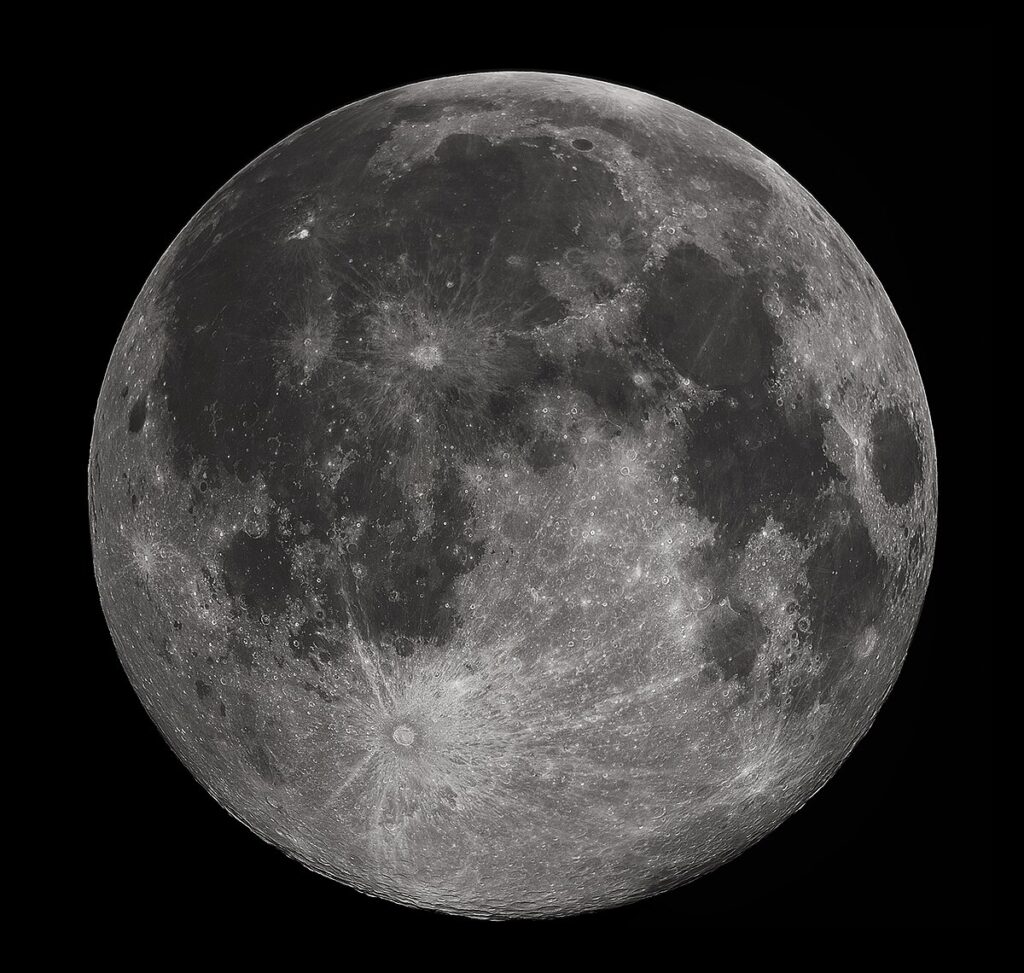
The Moon is Earth’s only natural satellite and the fifth-largest moon in the solar system. It shines as the brightest object in the night sky after the Sun and humans have known it since prehistoric times. The Moon’s desolate beauty has been a source of fascination and curiosity throughout history and has inspired a rich cultural and symbolic tradition. It’s gravitational pull on Earth causes tides, creating a rhythm that has guided humans for thousands of years.
The Moon’s size is slightly more than one-fourth of Earth’s, and it consists primarily of rock and dust. Its solid, rocky surface bears heavy cratering and pitting from impacts by asteroids, meteorites, and comets. The Moon has a very thin and weak atmosphere, called an exosphere, which does not provide any protection from the Sun’s radiation or impacts from meteoroids. The Moon’s origin is still a subject of scientific debate, but the prevailing theory is that it formed after a Mars-sized body collided with Earth several billion years ago.
The Moon has been the subject of numerous space missions, including the Apollo missions that brought back a total of 842 pounds of lunar rocks and soil to Earth. The Moon remains a prime location for humankind’s first settlements beyond Earth orbit, due to its nearness to Earth, its rich potential as a source of materials and energy, and its qualifications as a laboratory for planetary science and a place to learn how to live and work in space for extended times.
Europa: An Icy Shell Hiding a Liquid Ocean

Europa, one of Jupiter’s Galilean moons, is a fascinating world with unique characteristics. It is the sixth-largest moon in the solar system and is primarily made of silicate rock with a water-ice crust and possibly an iron-nickel core. Europa’s surface appears relatively smooth, with few craters, and a layer of ice covers it. Scientists are almost certain that hidden beneath this icy surface is a saltwater ocean with about twice as much water as Earth’s global ocean, making it one of the most promising places in our solar system to find environments suitable for life.
The moon’s smooth surface and the presence of a subsurface ocean have made it a subject of great interest for scientific exploration. NASA is planning to send the Europa Clipper spacecraft in 2024 to investigate whether Europa has the capability to support life, with the mission scheduled to enter orbit and begin its search in 2030. The potential for a subsurface ocean and the presence of essential chemical elements make Europa an intriguing candidate for the search for extraterrestrial life. The moon has also garnered interest in popular culture, appearing in various films, television shows, and literature.
Triton: A Nitrogen Geyser Wonderland

Triton is the largest moon of Neptune and the seventh-largest moon in the solar system. British astronomer William Lassell discovered it in October 1846, just 17 days after the discovery of Neptune itself. Triton is unique among the large moons of the solar system in that it moves in a retrograde orbit, opposite to the direction of Neptune’s rotation. Its mean orbital distance is about 354,800 kilometers (220,500 miles) from the planet.
Triton primarily consists of water ice with a substantial core of rock and metal, and it has a mean density of 2.061 grams per cubic centimeter, reflecting a composition of approximately 15–35% water ice. Methane and nitrogen ices cover the moon’s surface, and it boasts a remarkably low surface temperature of 38 K (−390 °F, −235 °C). Triton’s surface is relatively smooth, with few craters, and it features a polar ice cap presumably composed of nitrogen ice.
The moon’s surface additionally displays a cantaloupe-like terrain and dark streaks, with dozens of cryovolcanoes dotting it, spewing jets of water. Triton’s unusual orbital characteristics and surface features have sparked great interest in scientific exploration, often drawing comparisons with Pluto due to their similarities. The moon’s dynamic and active surface, along with its potential origin as a captured Kuiper Belt Object, have sparked scientific curiosity and led to proposals for future missions to study this enigmatic world in more detail.
Titania: The Largest Moon of Uranus
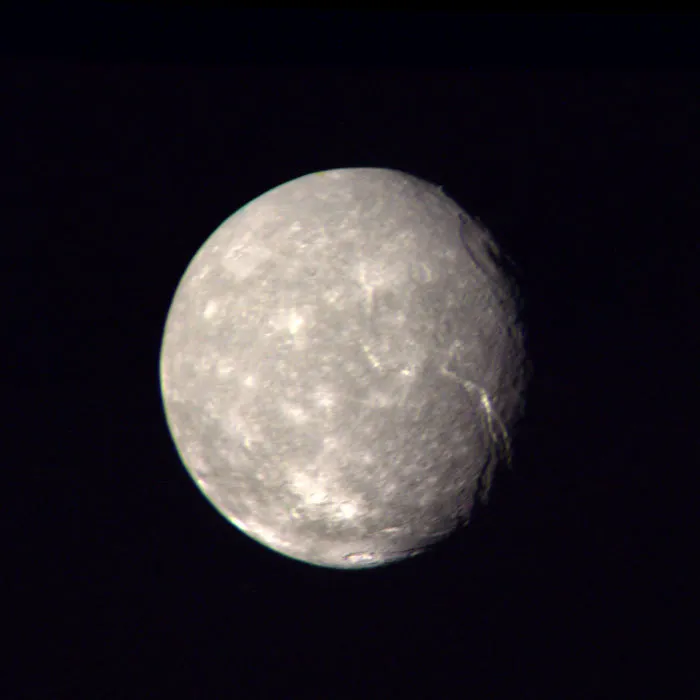
Titania, the largest moon of Uranus and the eighth-largest moon in the solar system, was discovered by William Herschel in 1787, it bears the name of the queen of the fairies in William Shakespeare’s play “A Midsummer Night’s Dream.” With a diameter of 1,578 kilometers (980 miles), consists of roughly equal parts water ice and rocky material, with a small amount of frozen methane.
The heavily cratered surface of the moon features a system of fault valleys, indicating some tectonic extension of its crust. Titania’s orbit lies completely inside the Uranian magnetosphere, and it is a synchronous or tidally locked satellite, with one face always pointing toward the planet. The moon’s orbit exhibits a small eccentricity and tilts very little relative to the equator of Uranus. Titania’s density of 1.71 g/cm3 is much higher than the typical density of Saturn’s satellites, reflecting its composition.
The Voyager 2 flyby in 1986 provided the only close-up images of Titania to date, revealing signs of geological activity, including the prominent system of fault valleys and deposits of highly reflective material, possibly frost, along the Sun-facing valley walls. Titania’s unique characteristics and its potential for harboring an internal liquid-water ocean have made it a subject of scientific interest and a target for future exploration.
Rhea: A Heavily Cratered Realm with Hidden Depths

NASA/JPL/Space Science Institute
Rhea is the second-largest moon of Saturn and the ninth-largest moon in the solar system. The Italian-French astronomer Giovanni Domenico Cassini discovered it in 1672. Rhea’s composition is primarily water ice, with a density of about 1.236 g/cm3, indicating that it consists of approximately 25% rock and 75% water ice. The moon has a heavily cratered surface, with a few large impact basins, and a rather typical appearance for a heavily cratered ice-rich moon.
Rhea has a tenuous atmosphere, also known as an exosphere, primarily composed of oxygen and carbon dioxide. The moon has been the subject of study by the Cassini spacecraft, which provided valuable insights into its surface features and composition. Rhea’s unique characteristics and its potential for harboring an internal liquid-water ocean have made it a subject of scientific interest and a target for future exploration.
Oberon: The Second-Largest Moon of Uranus
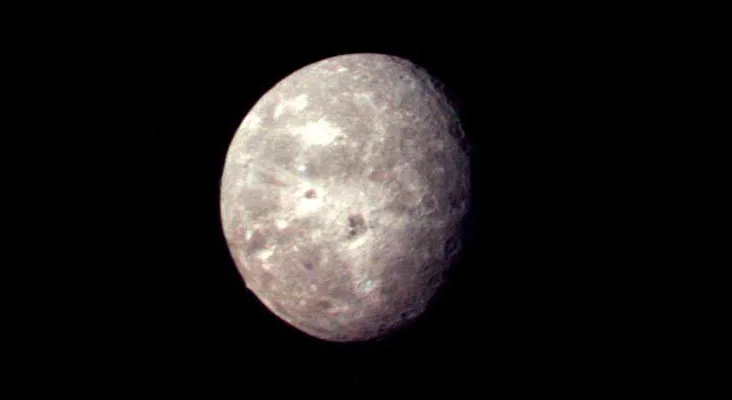
NASA/JPL
Oberon is the second-largest moon of Uranus and the tenth-largest moon in the solar system. It has a diameter of 1,522 kilometers (945 miles) and is the farthest from the planet among its five major moons. Oberon’s orbit has a small orbital eccentricity and inclination relative to the equator of Uranus. Its orbital period is around 13.5 days, coincident with its rotational period. In other words, Oberon experiences tidal locking, with one face always pointing toward the planet. Oberon spends a significant part of its orbit outside the Uranian magnetosphere.
As a result, the solar wind directly strikes its surface. This is important because the magnetospheric plasma, which co-rotates with the planet, strikes the trailing hemispheres of satellites orbiting inside a magnetosphere. This bombardment may darken the trailing hemispheres, a phenomenon observed for all Uranian moons except Oberon. Oberon is the second-most massive of the Uranian moons after Titania and the ninth-most massive moon in the solar system.
Gazing Forward: A Universe of Moons Awaits
Our journey through the top 10 largest moons concludes, but the quest for knowledge continues. Each of these celestial bodies serves as a testament to the diversity and wonder present in our cosmic neighborhood. From Ganymede’s hidden ocean to Titan’s methane lakes, and from Io’s volcanic fury to Callisto’s ancient scars, these moons offer invaluable insights into planetary formation, evolution, and the potential for life beyond Earth.
As we stand on the precipice of new discoveries, fueled by missions like Europa Clipper, Dragonfly, and Artemis, the future of lunar exploration promises to be exhilarating. These endeavors will not only deepen our understanding of these captivating moons but also inform our search for life in the universe, potentially revealing our place within the grand tapestry of existence.
Frequently asked questions
What is the largest moon in the solar system?
The largest moon in the solar system is Ganymede.
Which moon is the largest one orbiting Saturn?
Titan is the largest moon orbiting Saturn.
What is Jupiter’s third-largest moon called?
The third-largest moon of Jupiter is called Callisto.
Which moon of Jupiter is known for its volcanic activity?
Io, the moon of Jupiter, is known for its volcanic activity.
Is there potential for life on Europa?
Yes, Europa has potential for life.
What are some key facts about Earth’s moon?
Earth’s moon is our satellite and it plays a vital role in various aspects of our planet. It is also the only celestial body beyond Earth that humans have set foot on.
What mysteries are being unveiled through lunar exploration?
Lunar exploration aims to unveil mysteries about the moon’s formation, its geological history, and its potential for supporting human activities in the future.
What do astronomers study in relation to the solar system’s moons?
Astronomers study various aspects of the solar system’s moons, including their composition, geological features, and their interactions with their parent planets.
How many moons are larger than Earth?
There are four moons larger than Earth in our solar system. They are Ganymede, Titan, Callisto and Io
What are the largest moons made of?
The composition of the largest moons varies, but they generally consist of a combination of rock, ice, and other materials. The exact composition can vary depending on the moon.
